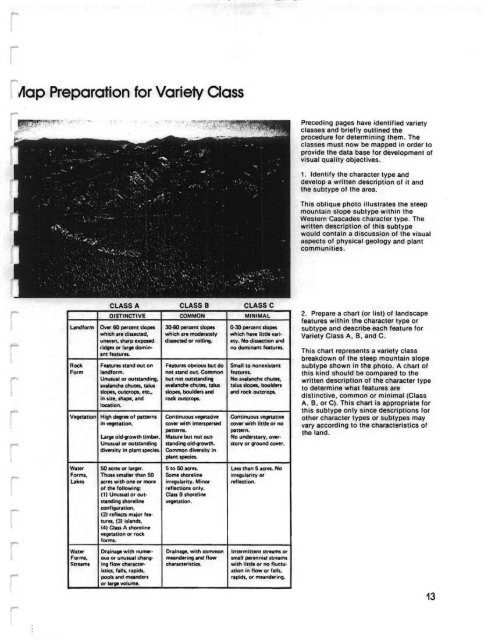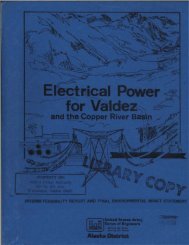Before the FERC Application for New License for the Annex Creek ...
Before the FERC Application for New License for the Annex Creek ...
Before the FERC Application for New License for the Annex Creek ...
Create successful ePaper yourself
Turn your PDF publications into a flip-book with our unique Google optimized e-Paper software.
lap Preparation <strong>for</strong> Variety Class<br />
Preceding pages have identified variety<br />
classes and briefly outlined <strong>the</strong><br />
procedure <strong>for</strong> determining <strong>the</strong>m. The<br />
classes must now be mapped in order to<br />
provide <strong>the</strong> data base <strong>for</strong> development of<br />
visual quality objectives.<br />
1. Identify <strong>the</strong> character type and<br />
develop a written description of it and<br />
<strong>the</strong> subtype of <strong>the</strong> area.<br />
This oblique photo illustrates <strong>the</strong> steep<br />
mountain slope subtype within <strong>the</strong><br />
Western Cascades character type. The<br />
written description of this subtype<br />
would contain a discussion of <strong>the</strong> visual<br />
aspects of physical geology and plant<br />
communities_<br />
Land<strong>for</strong>m<br />
CLASS A CLASS B CLASS C<br />
DISTINCTIVE COMMON MINIMAL<br />
I<br />
Over 60 percent slopes 30-60 percent slopes 0-30 percent slopes<br />
which are dissected, which are moderately which have little variuneven,<br />
sharp exposed dissected or rOiling. ' ety. No dissection and<br />
ridges or large domin-<br />
no dominant features.<br />
ant features.<br />
Rock Flitures stand out on Features obvious but do Small to nonexistent<br />
Form land<strong>for</strong>m. not stand out. Common features.<br />
Unusual or outstanding, but not outstanding No avalanche chutes,<br />
avalanche chutes, talus avalanche chutes, talus talus slopes, boulders<br />
I slopes, outcrops, etc., slopes, boulders and and rock outcrops.<br />
in size, shape, and rock outcrops.<br />
' location.<br />
I<br />
Vegetation High degree of patterns Continuous vegetative Continuous vegetative<br />
in vegetation. I cover with interspersed cover with little or no<br />
patterns.<br />
pattern.<br />
I.;Irge old-growth timber. Mature but not out- No understory, over·<br />
Unusual or outstanding standing old-growth. story or ground cover.<br />
I diversity in plant species. Common diversity in<br />
plant species.<br />
Water I 50 acres or larger. 5 to 50 acres. Less than 5 acres. No<br />
I Forms, Those smaller than 50 Some shoreline irregularity or<br />
Lakes acres with one or more I irregularity. Minor reflection.<br />
of <strong>the</strong> following: reflections only.<br />
(1) Unusual or out- Class B shoreline<br />
standing shoreline vegetation.<br />
configuration,<br />
I<br />
(2) reflects maior features,<br />
(3) islands,<br />
(4) Class A shoreline<br />
vegetation or rock<br />
<strong>for</strong>ms.<br />
Water I Drainage with numer- Drainage, with common Intermittent streams or<br />
Forms. ous or unusual chang- meandering and flow small perennial streams<br />
Streams ing flow character- characteristics. with little or no fluctuistics,<br />
falls. rapids.<br />
ation in flow or falls.<br />
I<br />
pools and meanders<br />
rapids, or meandering.<br />
or large volume.<br />
I<br />
I<br />
I<br />
2. Prepare a chart (or list) of landscape<br />
features within <strong>the</strong> character type or<br />
subtype and describe each feature <strong>for</strong><br />
Variety Class A, B, and C.<br />
This chart represents a variety class<br />
breakdown of <strong>the</strong> steep mountain slope<br />
subtype shown in <strong>the</strong> photo. A chart of<br />
this kind should be compared to <strong>the</strong><br />
written description of <strong>the</strong> character type<br />
to determine what features are<br />
distinctive, common or minimal (Class<br />
A. B. or C). This chart is appropriate <strong>for</strong><br />
this subtype only since descriptions <strong>for</strong><br />
o<strong>the</strong>r character types or subtypes may<br />
vary according to <strong>the</strong> characteristics of<br />
<strong>the</strong> land.<br />
13

















